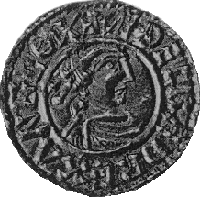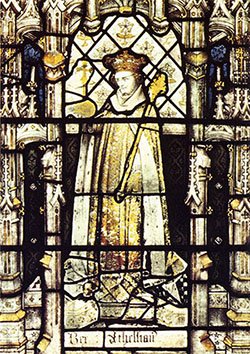Winchester Mint
Winchester Mint, like Winchester itself, was an important asset to the country it ruled. Control of the money system was imperative to a sound economy, no less important then than now.
For this reason the Mint was housed alongside the Royal Palace in Winchester where control would be simple. In its earlier years it was not just one place but several workshops where the creation of the different coins took place. How many workshops would depend on the economy at the time and the number did of course change. It became one workshop in Henry II's reign, still just outside the Royal Palace.
The importance of the Mint varied down the years, at one time it was the fourth principal mint in the country, at another time the second, at others, particularly towards the end of its life, it declined. Very much like the fortunes of the city where it lived.
The early Saxon economy in Winchester and the Wessex region would have been an agricultural one. The chalk downs around Winchester would have lent themselves to the rearing of sheep and by the early Norman period Winchester had a thriving and very important wool trade.

A Saxon coin of Ethelred's time
Photograph in the public domain
King Alfred no less than other monarchs would have needed a strong coinage. His was an active reign of both consolidation of his kingdom, economic activity and war against the Vikings with the necessity of building defences and a fast response. His capital was Winchester and the first coins to have the sign of the Winchester Mint appear during his reign.
The Mint continued into Norman times around the middle of the 1200's under Henry III's reign. Henry III, a long reigning monarch, was also known as Henry of Winchester. He was born in the city at Winchester Castle.
|
Craftsmen, or moneyers as they were called, who made and issued the coins would have had to be trustworthy people and were probably well thought of and well paid for their efforts. Their trade was a precise one, a coin had to be of the correct weight. Penalties, particularly from Aethelstan's reign in the second half of the 900's, were grim, that craftsmen would not have worked again with that type of mutilation of his hand. Aethelstan began the modern system of coinage law of correct value for the coin concerned. Coins from Roman, Saxon, Norman and medieval eras can be seen in the Museums of Winchester. |
 King Athelstan. 895-939 |
There are plenty of Anglo Saxon coins around the world. Quite a lot in Russia that arrived there via the Danegeld. Viking invasions went as far as Russia and trade followed. In Britain hoards of coins have been found and also the coins that were lost and never found. Just imagine a coin of today you have just lost turning up again a century later!
No sign of Winchester Mint can be seen now, but in its time the Mint was a significant asset to the city, Wessex and England.

Other pages that may be of interest
Exploring Winchester High Street
History of Winchester Cathedral

Return from Winchester Mint to Home
Or you may prefer to browse some more, please do, you will find navigation buttons above on the left.



